We'd Like to Hear from You
Northwestern welcomes signed letters of 250 words or less from readers. We reserve the right to edit all letters. Please send correspondence to the
Editor
Northwestern
1800 Sheridan Road
Evanston, IL 60208-1800
Fax: 847-491-3040
E-mail: letters@northwestern.edu
Find Us on Social Media
A WELL-THROWN PITCH
I’m the perfect audience for the cover story [”Chasing the Dream,” fall 2016] on Luke Farrell: a Northwestern alum, a Boston native who bleeds Red Sox and a baseball fan who is curious about life in the minors.
You checked all the boxes.
I, of course, have followed [Red Sox manager] John Farrell’s career but didn’t know about Luke’s brothers or grandfather.
The toast story is a classic. It’s a wonder the fire marshal permits a working toaster in the stands.
Richard Harris ’76
Bethesda, Md.
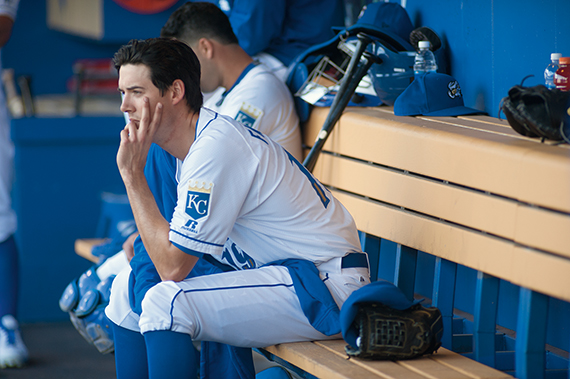
Luke Farrell watches the Omaha Storm Chasers bat in the home half of the first inning during the May 12 game against the Memphis Redbirds. Farrell gave up two earned runs in 5 1/3 innings and earned the win. Photo by Robert Ervin.
VOTING RIGHTS CURTAILED
It is stunning to me that in the article “Voting Rights Curtailed” [fall 2016] the word Republican was barely mentioned. In fact, only one paragraph in the entire article made any connection between voter suppression and the Republican Party. All the states that are suppressing voting rights are states with Republican governors and Republican-led legislatures. Thankfully some lower courts have stepped in to stop this egregious violation of people’s right to vote. In the current political season, when the Republican presidential candidate operates in a fact-free world, it is of vital importance to help Americans to get the facts straight when possible.
Adrienne Maisel Hugo ’76, ’77 MA
Mundelein, Ill.
The article about expanding voting rights makes good sense if you are a Democrat. I can’t understand why it is such a burden to get an ID. Try getting on an airplane without an ID. Obviously, the Democrats want more voters because they love the uninformed voter. This is just another example of the political correctness of “inclusiveness,” which is a sham. The country is not necessarily better off with more voters — what we need is more intelligent voters, but of course that doesn’t fit the Democratic narrative!
Dan Schuchardt ’79 MBA
Glen Ellyn, Ill.
I was very interested to read about my home state of North Carolina in the article “Voting Rights Curtailed.” Apparently having a photo ID is considered a hardship by the courts, especially if the potential voter lives in a rural area. Really?
I think that a DMV office within 10 miles of your home would be close enough. Is it safe to assume that these same people also have trouble applying for a job, opening a bank account, passing security to board a plane, visiting the doctor’s office and buying alcohol?
Equally amazing was the claim made by Ms. Wylecia Wiggs Harris of the League of Women Voters that there is no evidence of voter fraud. I suppose she has never heard of John Fund? I’ve heard anecdotal evidence of voter fraud: A vanload of voters visiting a polling place and casting a vote for only one candidate on a ballot full of offices and issues before leaving. When asked about their haste, one voter replied that they were only told to vote for one person. These were not people on their lunch hour!
Debbie Roberts Schmidt ’87
Cary, N.C.
Terry Stephan’s story “Voting Rights Curtailed” raises pertinent points about electoral rights. A report called “The High Cost of ‘Free’ Photo Voter Identification Cards,” published by Harvard Law School’s Houston Institute, addresses some of these concerns. First, obtaining a “free” voter identification card can typically cost between $75 and $175 for documents, travel and time expenses. With legal fees, the costs can increase to $1,000.
As Stephan’s article notes, Justice John Paul Stevens now questions his approval of a restrictive Indiana voter ID law, as evidence increased that voter IDs impede voting of minorities, women, students and the elderly. Federal appellate Judge Richard Posner in Chicago, who originally voted to uphold the Indiana law, now regrets his decision. Citing the Houston Institute figures, he vigorously dissented in Wisconsin’s voter identification case. He further argues that investigations show the likelihood of in-person voter fraud, the alleged justification for voter ID laws, is lower than being struck by lightning: less than one in a million!
The article also explains how the maze of voting restrictions, including proof of citizenship (a key citizen right is not having to prove it), purging voters, restricting early voting, and long lines and waiting time (which ID checks increase), impedes that right. The goal of electoral resources needs to be to increase education and participation, not to abridge exercising a most valued American right.
Richard Sobel
Visiting scholar
The Roberta Buffett Institute for Global Studies
Northwestern University
While I would fight to insure that every citizen has the right and opportunity to vote, I totally disagree with the premise of the article.
Voting rights are not curtailed simply because citizens are asked to provide an acceptable form of identification within seven to 10 days of the “normal” election day and to provide an acceptable form of identification (in Florida, the list of acceptable forms of ID is quite long and includes free government-provided cards).
This article continues the media storyline that we're all “victims” of some crazy right-wing conspiracy. Nothing could be further from reality.
Rick Gordon ’80 MBA
Gulf Breeze, Fla.
DANGER IN TIMBUKTU
Your article on Dr. Robert Murphy [“From Here to Timbuktu,” fall 2016] was fascinating. He clearly has made many major contributions to health care, especially in developing countries where health care systems are under great stress — if they exist at all. For that he deserves tremendous praise, and I hope that many others will follow in his footsteps.
But those same footsteps can lead in dangerous directions. I see that Dr. Murphy worked with the Peace Corps as a consultant many years ago. One of my daughters served in the Peace Corps in Mali from 2010 through 2012. We had an opportunity to visit her there and saw the massive needs and the amazing generosity of these people. Her entire Peace Corps group was pulled out of Mali when there was a coup in 2012. Even at that time Timbuktu was off limits to visitors.
I understand why Dr. Murphy wanted to go to Timbuktu, and I see the value in what he found there. However, I believe it was very unwise on his part to disregard travel advisories. This area can be a very dangerous place for Westerners. He would have been a very high-value target. By going there without a permit he was risking not only his own life but also that of an unknown number of others who might have been called to rescue him.
Rita LaDoux
St. Paul
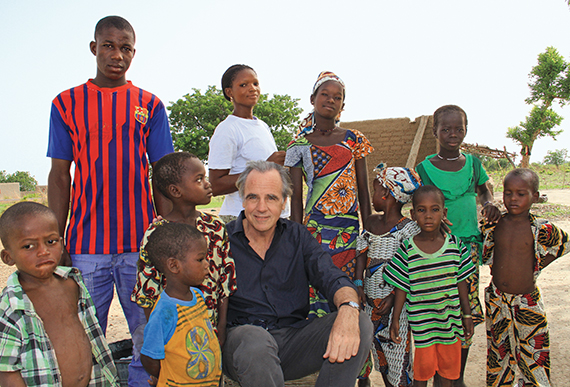
On the side road to Timbuktu, some villages had only one or two families left. Robert Murphy checked on some of these families and provided basic primary care and prescriptions. Photo by Emilio Williams.
CALL FOR MORE DIVERSITY
After reading President Morton Schapiro’s letter to the Northwestern community [“Opening New Doors,” fall 2016], one quote gave me pause: “This year’s entering undergraduate class of approximately 1,950 first-year students will be our most talented and most diverse ever.” I have lived a different story.When I graduated and joined Teach For America’s 2006 corps, I never dreamed I would stay in education beyond my two-year commitment. But I used my Wildcat grit and persevered, and a decade of teaching later, my life has been immeasurably enriched by my students.
Every student I have taught identifies as a person of color; most are from low-income homes and are the first in their families to attend college. One more stat: Every student I have taught who has applied to Northwestern has been rejected. And yet, those same students have been thriving at all of Northwestern’s competitors, like Princeton, Vanderbilt, Yale, Rice, MIT, Columbia, Stanford and Georgetown. My scholars are clearly capable of excelling at Northwestern, but they haven’t been given the opportunity.
I’ve concluded that it’s not my students — it’s Northwestern. I have taught 10 years worth of knowledgeable and driven scholars whose presence — certainly not limited to but including the diversity they represent — would enrich the Northwestern community. Our great university must prove that diversity truly matters. That should start by examining how we recruit and review applications for students like mine.
Emily Peck Shisler ’06
Brooklyn, N.Y.
Editor’s note: According to Christopher Watson, Northwestern’s dean of admission, the acceptance rate for undergraduate admission now stands at approximately 10 percent and the University receives about 35,000 applications for an entering class of approximately 1,950. Therefore, a significant number of applicants do not receive offers of admission despite having strong credentials. Despite the lowest acceptance rate in the University’s history, the class of 2020 is quite diverse, with 22 percent under-represented minorities, 11 percent first-generation college students, a record number of students from Chicago Public Schools, and 18 percent of the students eligible for Pell grants, which are available to students from low-income families. Northwestern is committed to providing access for academically qualified students of all backgrounds and encourages our alumni to recommend outstanding high school students for admission.
GIVE YOUR PATIENTS YOUR EAR
Dr. Julia Michie Bruckner’s well-written essay [“The Doorknob Complaint,” fall 2016] highlights an important aspect of patient care that today’s young physicians need to remember when seeing patients: continue to listen to your patients’ even minor or unusual complaints despite modern pressures for efficiency and productivity.
Alex Froyshteter ’08
Chicago
GOOD COACH
I was shocked and pleasantly surprised to see a photo [below] and class note on my high school (East Leyden) football coach and physical education instructor, Jack Leese [Alumni Life, Class Notes, page 50, fall 2016]. In appearance back then Leese was just like a Marine drill instructor with a presence that could easily intimidate a teenager. I attended the high school from 1964 to 1968 and had some bad habits at the time, smoking for one. In between classes we would smoke in the restrooms as quickly as possible. I was usually one of the last students out of the locker room for phys ed, at which point Coach Leese would say, “Well, Mr. Pasko, did you enjoy your cigarette?” My response was to just smile.
I am glad to see he is enjoying the fruits of his labor and wish him the best of health. By the way, you can tell him I quit smoking a few years later.
Walter Pasko ’90 MBA
Waterloo, Neb.
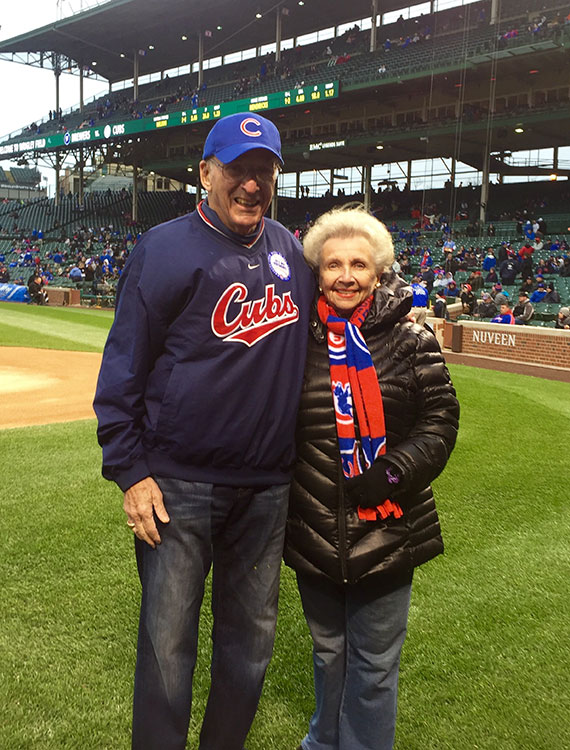
Editor’s note: We asked Jack Leese to confirm Walter Pasko's recollection. Here's his reply:
In regard to Walter Pasko, I can say he tells a good story. My olfactory sense enabled me to smell smoke easily, and while not catching him, and many others, in the act, I wanted to let them know they were not fooling anyone, only themselves. I learned early in my teaching career to treat students as they should be and not as they are, hence the “Mr.” Pasko. I am glad he got smart (MBA), and also quit smoking. I am now 85 and have been gong to the East Leyden 50-year reunions for the past three years. I plan to go to the class of 1968 reunion and hope to reconnect with Mr. Pasko then. He will be about 68 years old then. I am glad he took the time to write.
In closing, I am going to add two things:
1. As Henry Adams has said, “A teacher (coach) affects eternity. You never know when his influence stops.”
2. You die twice. Once when you leave earth, and then when no one remembers you. I am glad Mr. Pasko remembers me for whatever the reason.
Regarding "enjoying the fruits of my labor," my wife and I have been married to each other for 61 years, and during our retirement have traveled out of the country for at least once a year for the past 25 years. We live in the city, 30 floors up, look out the west window and see Wrigley Field, looking south, we have a mile and a half of front yard before we see downtown, with Lake Michigan on our east side. If I said more I would be bragging, and I am actually low keyed. I had people interested in me enough to suggest I go to Northwestern University. Listening to them was one of the smartest things I did in my life, and I am glad I did.
Jack Leese '57, '58 MS
Chicago
BREWBIKE NEEDS TO OFFER SANDWICHES
Reading “Brewing up Business” [Campus Life, Student Scene, page 14, fall 2016] and seeing a photo of the BrewBike triggered an immediate flashback to the Sandwich Man (see "Then: The Sandwichman," spring 2013) and his infamous pushcart that graced the quads in the ’70s and ’80s.
I think Geduld and Philips are on to something. Perhaps they should consider adding PB&Js, ice cream sandwiches and, of course, milk. How about a trusty German shepherd companion as well?
Let’s see an archival photo of the “Sandge” opposite the BrewBike!
Mark Matray ’77
La Grange, Ill.
Editor's note: Here you go:
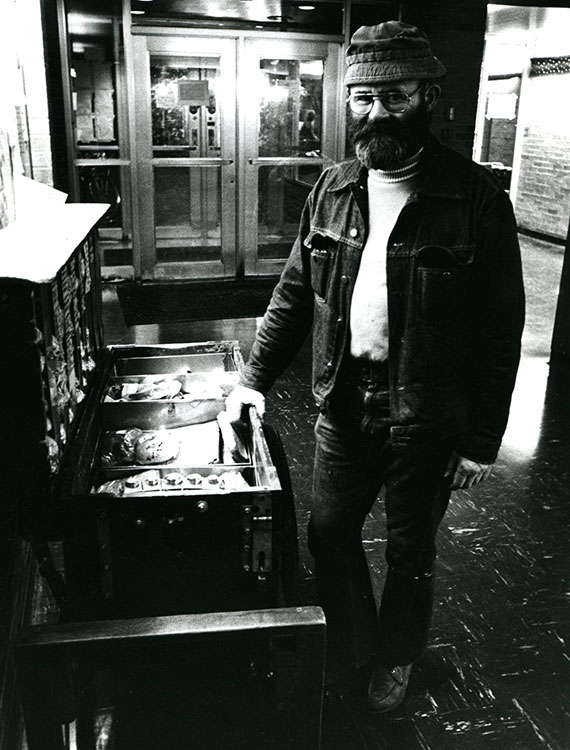
The Sandwichman, William Froehlig, with his food cart that carried 18 kinds of sandwiches, milk and ice cream sandwiches. Froehlig was known for his trademark whistle that he would use to announce his arrival at campus residence halls. Photo by William Cork (McC82, WCAS82)/Courtesy of the Syllabus.
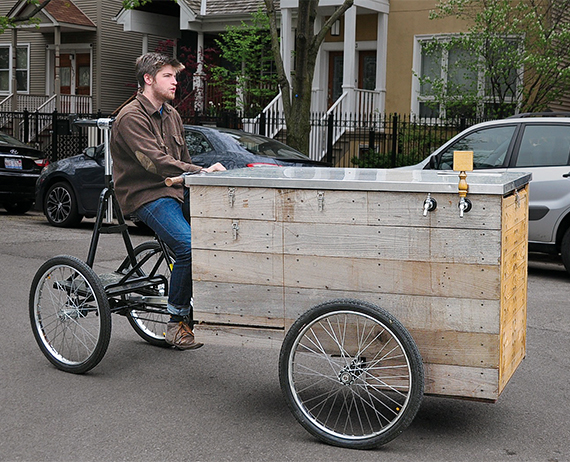
BrewBike will serve up cold-brew coffee from a custom-built bike from Chicago-based Heritage Bicycles. Photo courtesy of BrewBike.



 Facebook
Facebook Twitter
Twitter Email
Email


